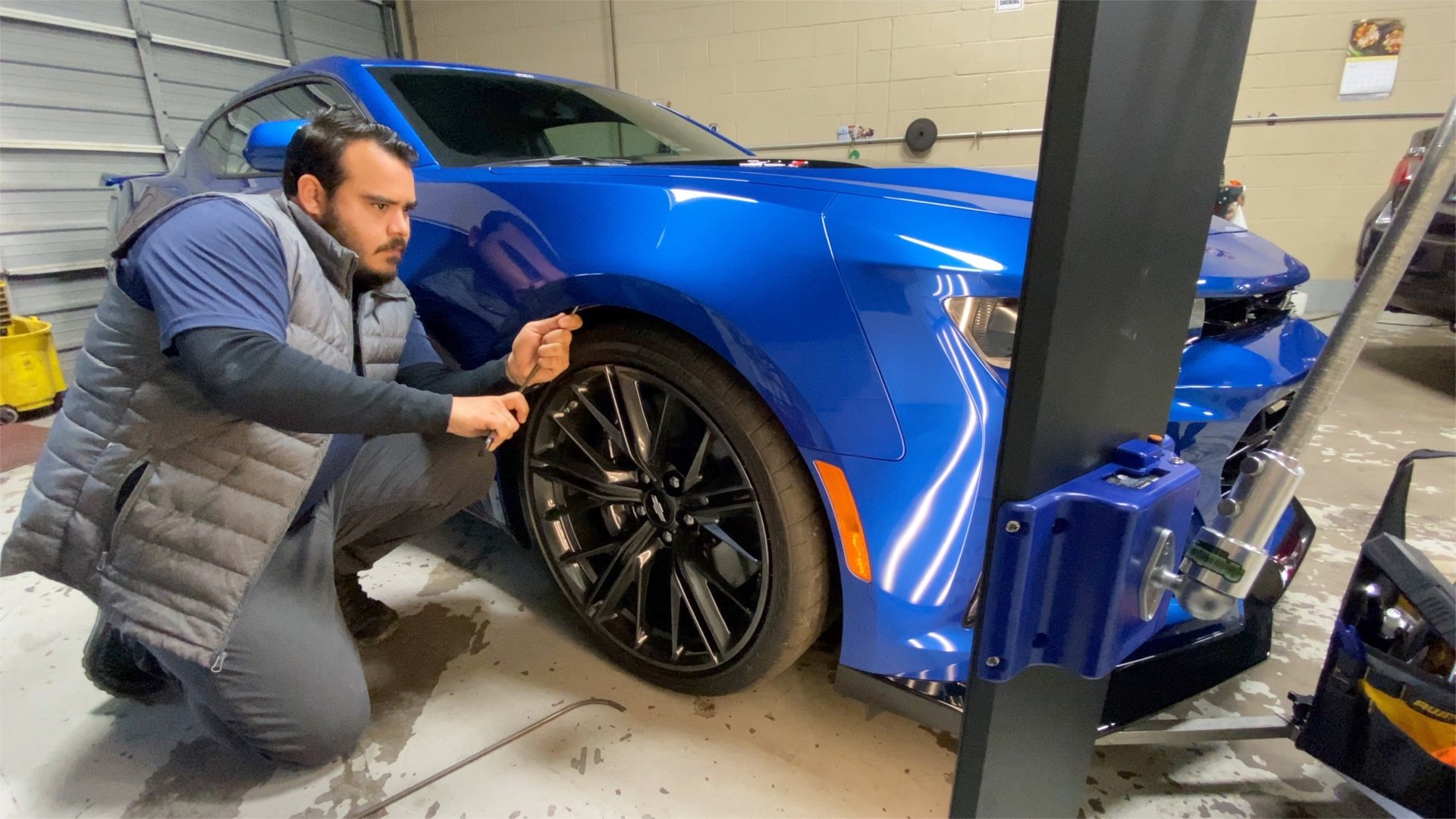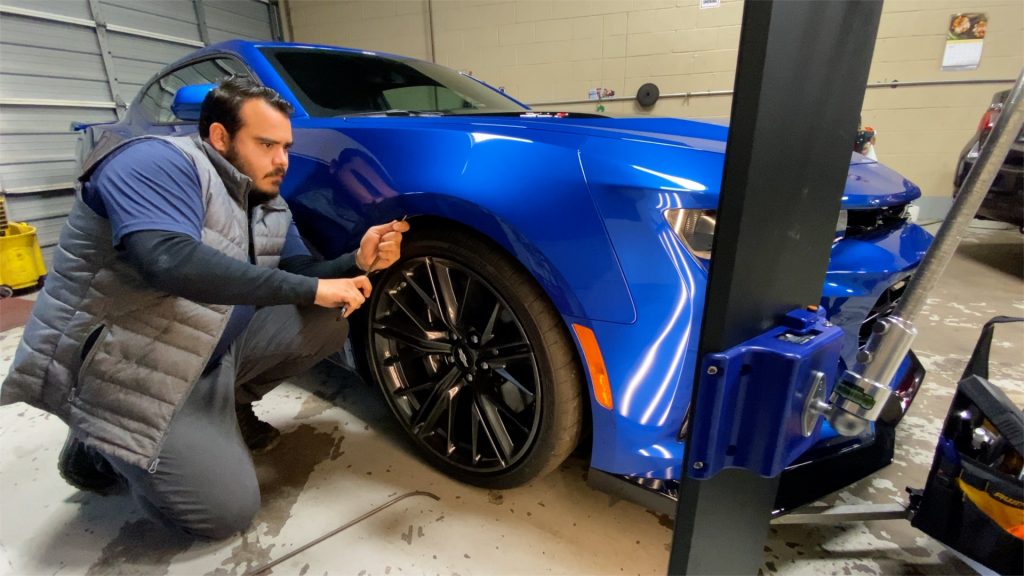5 min read
Everything You Need to Know About Paintless Dent Repair
By: Christopher Ray on Nov 4, 2019 11:38:00 PM


Is there anything more frustrating than finding a door ding?
Sure, you can’t classify one of these small dents as significant damage.
That said, dents and dings can be unsightly. And for those who pride themselves on their ability to take care of their cars, they can be an acceptable cause of frustration.
Fortunately, thanks to paintless dent repair, annoying dents and door-dings can be a thing of the past for discerning car owners.
Are you ready to say goodbye to minor dents and dings once and for all, but aren’t sure where to start? We’ve got you covered.
Here’s everything you need to know about paintless dent repair and how it can benefit you and your beloved ride.
What is Paintless Dent Repair?
Paintless dent repair, or PDR, removes dents from the body of your vehicle quickly, without having to apply any paint or filler.
With PDR, specialists repair dents by using specialized tools and techniques to manipulate the body of the car itself back into place. So, your vehicle ends up looking just like it did when it first came off the line.
While PDR is one of the most effective forms of dent removal, it’s not appropriate for every repair job.
The Difference Between PDR and Traditional Dent Repair
With traditional dent repair, specialists would smooth over the indent with filler, then paint over the patch job to match the rest of the car.
While this method can be useful, it only covers the dent. It does nothing to repair the initial problem.
On top of that, the use of fillers and automotive paint can wind up being pretty expensive — no matter how small the dent.
With PDR, autobody specialists can get your vehicle looking like new again just by manipulating the body. Because of this, PDR tends to be much a much faster and cheaper alternative to traditional autobody repair.
How to Know if PDR is Right for You
Paintless dent repair won’t be able to help you with significant bodywork. But it’s the perfect solution to the little dents our cars pick up thanks to everyday wear and tear.
PDRÂ can help get rid of shallow dents, that are generally smaller than 4-inches, like minor damage from hailstorms or door dings.
PDR Techniques
There’s more than one way to repair a dent without having to use any extra paint or fillers.
When it comes to PDR, there are a few different techniques your autobody specialist might use to reshape your car and get it looking like new again.
Here are a few of the most popular PDR techniques, and how they can help get rid of dents and door dings from your vehicle.
Blending
The blending process works by using a few good vibrations to help your car whip itself back into shape.
Your car’s body has a memory. It knows what it should look like, and when given a little room to move, it can take care of dents on its own.
During the blending process, a technician uses a tool called a blending hammer around the affected area to create vibrations. These vibrations allow your car to basically “shake out” the dent all on its own.
Pushing
This technique works just how you think it would.
With the pushing technique, technicians use special rods, hooks, flat bars, and other tools to go inside the body and push the dent out from behind.
Due to the high level of precision and control, this technique offers, technicians can use it to take out pretty much any dent you can throw their way.
Knockdown
Dents don’t always go inward. Sometimes you can wind up with a small outward bump that’s just as frustrating and unsightly as any other dent.
And, when it comes to outward dents, the knockdown technique can help technicians smooth your car out again.
With this method, specialists “knockdown” protruding dents with the help of a specially made tool and a series of removable tips.
These tips will not damage your car’s paint job and come in a wide range of styles and sizes, so they can take on any outward dent you can throw their way.
Glue Pulling
For dents technicians can’t get behind to push out, there’s the glue pulling technique.
The glue pulling technique works by applying a bit of hot glue onto a glue-pulling tab and stick it in the center of the dent you’re trying to remove.
You then use a dent lifter that works with the glue-pulling tab to pull out the dent.
While this technique can be fast and easy, it can inadvertently create minor outward dents, which you’ll need to knockdown. So, it can wing up taking a bit longer than other methods.
Magnetic Induction
This method uses some of the latest and greatest technology to help repair dents quickly and easily.
Heat magnetic induction works by heating the metal in your car’s body to make it more mailable. Like with the blending method, this technique hinges on your car’s ability to fix itself.
Heating the metal behind the paint relieves the stress of the dent and can allow it to smooth out all on its own.
How Long Does PDR Take?
One of the other benefits of choosing PDR over traditional dent removing methods is that is can be much, much faster.
There is no waiting around for paint to dry or for filler to set. Once your specialist pops your dent out, you’re good to go.
So, how long will it take a PDR specialist to get the dents and dings out of your car?
Depending on the number and severity of the damage, it could take anywhere from a few hours to 30 minutes.
While a lot of hail damage could see you waiting around for three or so hours, your specialist will be able to fix a minor door ding in a matter of moments.
Booking Your Paintless Dent Repair Appointment
Now that you know how paintless dent repair can help you get your car back into tip-top shape, why not go ahead and book an appointment?
Request a quote today to get started.
Related Posts
How to Get Rid of Dents Without Ruining Your Paint
If you have a dent in your car, don't worry! There is a way to get rid of it without ruining your...
The Advantages of Using Paintless Dent Repair for dents on your car
Imagine yourself walking out to your car and spotting a sizeable dent on one of the doors or the...
Why Paintless Dent Repair Is not for Everyone
When it comes to Paintless Dent Repair (PDR), not everyone can master the skill required to remove...
